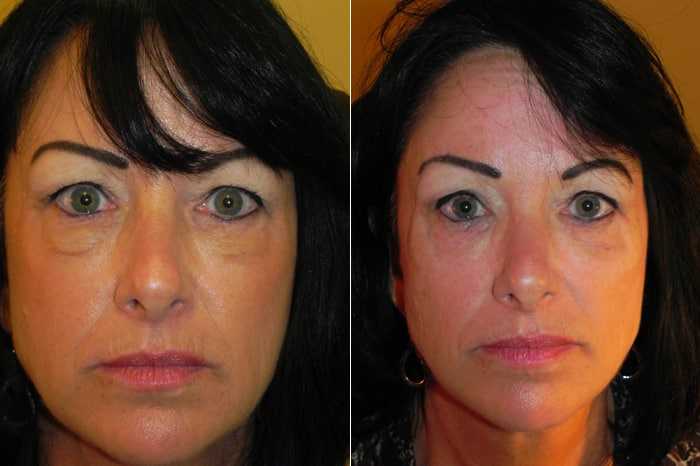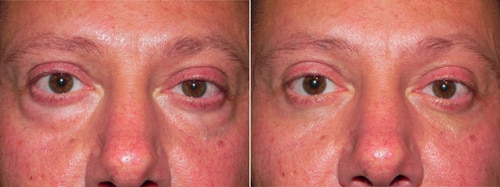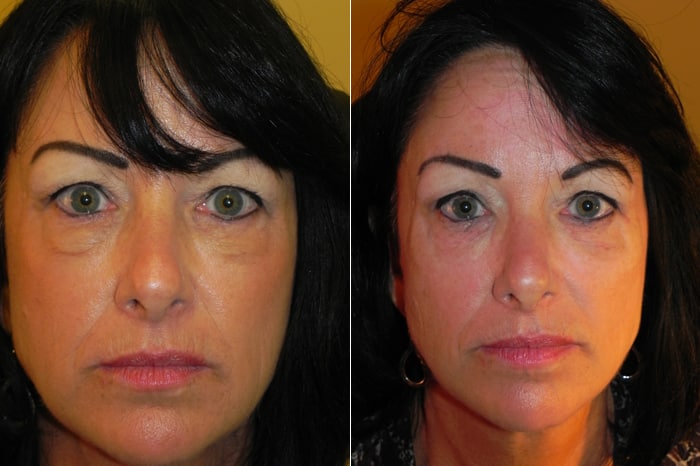The aging process can lead both men and women to develop dark circles under their eyes. There are a number of different things that cause these dark circles, but one of the most common causes is the shifting of fat from around the eyes to under the eyes.
What Are “Bags,” And How Can They Be Fixed?
As we age, certain natural changes occur to our faces in general and our eye region in particular. First, the eye socket changes and enlarges, allowing the fat around the eyes to shift to a more forward location, as shown by research performed by Dr. Robert Shaw at the University of Rochester.
The second cause of under-eye bags is the actual growth of fat as we age, as revealed by research performed at the University of California Irvine by Dr. Sean Darcy.
Both of these changes shift fat from around the eye into the lower eyelid space, creating fullness otherwise known as lower eyelid bags.
The unfortunate thing about this shifting fat is that it occurs in one of the most important parts of the face when it comes to non-verbal communication. When we interact with one another, our subconscious brain scans the other person’s face for facial cues. When we see fullness in the lower eyelid region, our brain usually interprets this to mean the other person is tired, sick or sometimes even drunk, whether this is true of the other person or not.
Needless to say, this can be frustrating for people who have these “bags.” In most cases, the best way to address this condition involves lower lid blepharoplasty to either remove or reposition these bulging fat pads, which can restore the eye area back to a more natural and smooth appearance.
When Fillers Are Used Improperly
Because these changes around the eye can be so distressing, many patients seek help in improving their appearance when these changes occur. Unfortunately, in today’s world many different types of practitioners are performing cosmetic procedures, including those who don’t have any background in plastic surgery. The skill set and knowledge of these practitioners can vary. As a result, many practitioners use fillers in the lower eyelid region in an attempt to camouflage the appearance of lower eyelid bags, but this can actually lead to awkward and cosmetically unattractive results.
While some skilled practitioners are able to get adequate results with fillers placed in these areas, I have seen more problems with fillers than successes. In my practice, people come from around the world for help with my surgical services, and I’ve seen many different types of fillers from around the world that have been placed under patients’ eyes. The results of these fillers when used to camouflage lower lid bags are usually very poor.
Thankfully, the great majority of fillers placed in the lower eyelid by practitioners are a class known as Hyaluronic Acids. Included in this category are Belotero® Restylane® and Juvederm®. These hyaluronic acids can be dissolved or “erased” using another injectable solution called hyaluronidase. This allows me to reverse the often-awkward results of fillers used improperly and then help my patients with my more definitive surgical procedures.
Unfortunately, some practitioners have used classes of fillers which can’t be reversed, such as Sculptra® and Radiesse®, fat, Bellafill® and Silicone. This can be devastating to patients because these fillers cannot be easily reversed and are often permanent.
As a surgeon, I have many tools available to me to help my patients. A non-surgeon, however, has fewer tools available and, as I like to remind patients, “when all you have is a hammer, everything looks like a nail.” It’s important to have a wide range of abilities when helping patients to ensure the solution you’re providing is the most effective, and in today’s world, unfortunately, many cosmetic injectors do not have this.
When fat is protruding in the lower eyelid space, the best option is not fillers but rather surgery to definitively correct the anatomic problem. Cosmetic injectors with varying skill sets and knowledge would help their patients better if they referred them to a qualified surgeon instead of trying to see every patient as a nail.
The Exception to the Rule
Having said this, I do find one appropriate use for fillers under the eyes, and this is in the rare circumstance when people have true hollowing under their eyes.
I see this most often in young patients, and it is caused by a lack of normal fullness in this area. When fillers are placed in this region, they can help improve dark circles under the eyes.
So while fillers are not the best way to fix under-eye bags caused by aging—and can in fact make this condition look worse—they do have a use for certain young patients with lower eyelid hollowing.
In Conclusion
- The aging process often affects the eye region.
- Although fillers have a role in improving lower eyelid hollowing (especially in younger patients), they do not do well when it comes to treating lower eyelid bags caused by aging. These are better addressed with surgery.
- When fillers are used in the lower eyelid region, it’s important they be the type that can be dissolved easily (i.e. hyaluronic acids).
- Finally, when seeking help with this area, it is always best to seek a specialist with many surgical tools in their clinical toolbox rather than a generalist to whom “everything looks like a nail.”
Shaw, R., Katzel, E., Koltz, P., Yaremchuk, M., Girotto, J., Kahn, D., & Langstein, H. (2011). Aging of the Facial Skeleton: Aesthetic Implications and Rejuvenation Strategies. Plastic and Reconstructive Surgery, 127(1), 374-383.
Darcy, S., Miller, T., Goldberg, R., Villablanca, J., Demer, J., & Rudkin, G. (2008). Magnetic Resonance Imaging Characterization of Orbital Changes with Age and Associated Contributions to Lower Eyelid Prominence. Plastic and Reconstructive Surgery, 122(3), 921-929.








